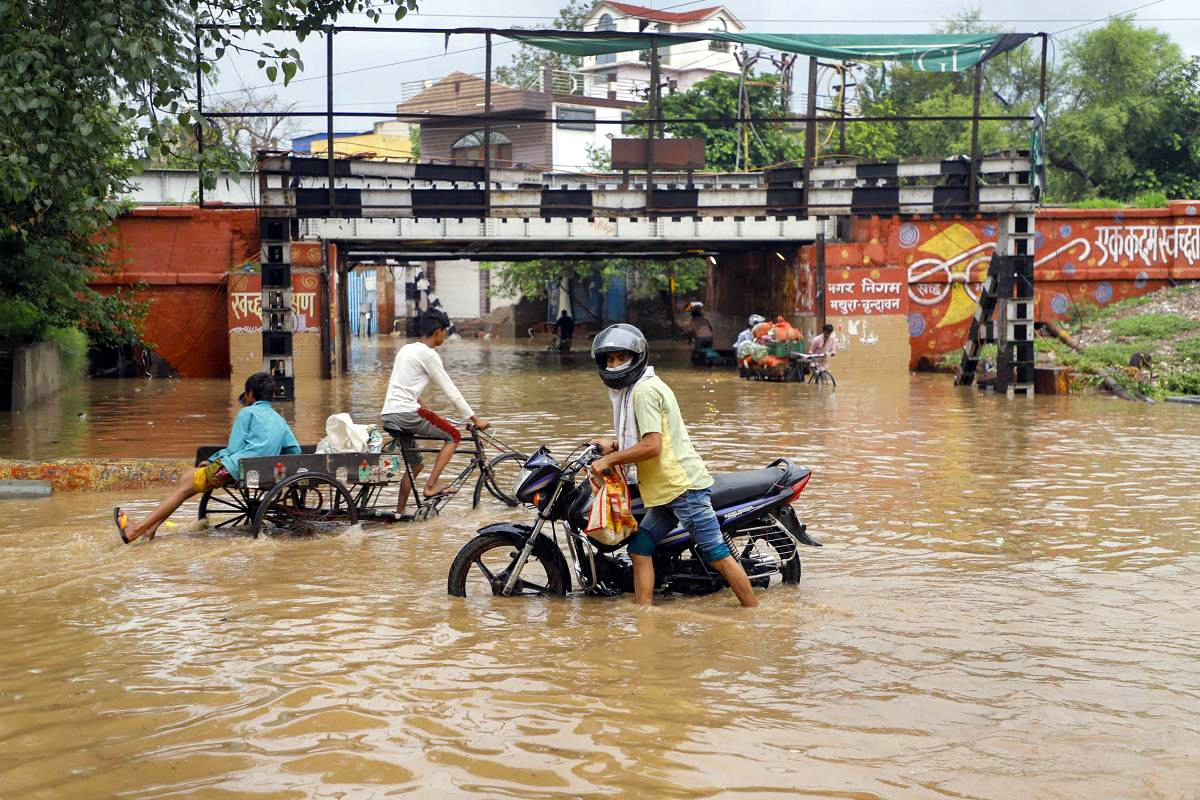NEW DELHI, July 11: The rain ebbed in some places in north India and pelted down in others on Tuesday with at least seven more people dead and hundreds stranded as raging waters gushed through villages, towns and fields – from the desert state of Rajasthan to the hills of Himachal Pradesh.
State governments stepped up relief and rescue efforts in the affected districts, navigating the trail of destruction left behind by the incessant downpour of the last three days.
Four of the latest fatalities were reported in Uttarakhand and the rest in Uttar Pradesh, Rajasthan and Punjab. This is in addition to the 37 deaths reported till Monday.
In Himachal Pradesh, which is among the worst hit and where at least 300 are stranded, the meteorological department warned of the possibility of moderate to high flash floods in Shimla, Sirmaur and Kinnaur districts.
Northwest India saw incessant rainfall during the last three days, with many areas in Jammu and Kashmir, Uttarakhand, Himachal Pradesh, Haryana, Uttar Pradesh and Rajasthan recording “heavy to extremely heavy” precipitation.
This resulted in overflowing rivers, creeks and drains that have massively damaged infrastructure and disrupted essential services in Jammu and Kashmir, Himachal Pradesh, Uttarakhand and Punjab.
In the national capital, the Yamuna has exceeded the evacuation mark of 206 metres, prompting the relocation of people residing in flood-prone areas to safer locations and a closure of the Old Railway Bridge for road and rail traffic.
The river crossed the danger mark of 205.33 metres in Delhi on Monday evening, much earlier than anticipated. According to the Central Water Commission (CWC), the water level at the Old Railway Bridge rose from 205.4 metres at 5 pm on Monday to 206.38 metres at 12 noon on Tuesday with Haryana releasing more water into the Yamuna from the Hathnikund barrage in Yamunanagar.
In Uttarakhand, four pilgrims from Madhya Pradesh died and seven more were injured when a landslide triggered by heavy rainfall buried three vehicles near the Gangnani bridge on the Gangotri National Highway in Uttarkashi district on Monday night.
Three of the four bodies have been recovered and efforts are underway to pull out the fourth from the rubble, an official said, adding that two of the seven people injured are in serious condition.
Floods in the Jummagad river in Chamoli district on Monday night washed away a bridge built on it, blocking the Indo-Tibetan border road and snapping contact with over a dozen border villages. The bridge was located near Jumma village on the Joshimath-Niti highway, about 45 km from Joshimath.
In Himachal Pradesh, an Indian Air Force helicopter was requisitioned to airlift the tourists stranded at Chandertal in Lahaul and Spiti district but it had to return due to bad weather conditions. A rescue team from Kaza has reached Kunzum Top and is just eight kilometres away from the lake, officials said.
Around 300 people, mostly tourists, are stuck in camps at Chandertal, located at an altitude of 14,100 feet, following rain and snowfall in the region. All the stranded people would be evacuated to safe places by Tuesday night, officials said, adding that about 100 people were rescued from different places in the hill state on Monday.
Two teams have been deputed for road restoration — one from the Losar side and the other from Kaza. The team comprises members of the administration, Indo-Tibetan Border Police (ITBP), Border Roads Organisation (BRO), police and local villagers, they said.
The officials said since the onset of the monsoon on June 24, Himachal has suffered a loss of Rs 780 crore and the figure is expected to go up as excessive damage has been caused to roads, bridges and water supply schemes.
The rains have stopped since Monday evening and the rescue operations and road restoration work have gained pace.
Chief Minister Sukhvinder Singh Sukhu is slated to visit Kullu, Lahaul and Spiti and Mandi during the day.
In Punjab and Haryana, the weather cleared on Tuesday after three days of incessant downpour, which left behind a trail of destruction in several parts of the state.
Officials said relief shelters have been set up in the affected districts in the two states, including Rupnagar, Patiala, Mohali, Ambala and Panchkula.
In Punjab’s Hoshiarpur, a 75-year-old man died after the roof of his mud house collapsed due to heavy rains on the intervening night of July 9 and 10. In Sultanpur Lodhi, a 24-year-old man is feared to have drowned in the floodwaters of the Sutlej river near Shahkot while trying to hold on to his motorcycle in the flooded Chitti rivulet.
A total of 730 girl students of a residential school in Haryana’s Ambala City were shifted to Kurukshetra after floodwaters entered their hostel complex following a beach in the Ghaggar river on Monday night.
Since the level of the Yamuna river at the state’s Hathini Kund Barrage was rising constantly, people in adjacent low-lying areas have been asked to stay away from the riverbank, officials said.
At 9 am on Tuesday, around 3.21 lakh cusecs of water was discharged from the barrage, the officials said. This is reportedly the highest quantity of water released from the barrage this year.
Many villages of Yamunanagar, Karnal, Panipat and Sonepat districts, and those adjoining the Yamuna river have been put on alert.
There has been a breakdown in the power and water supplies in some of the worst-affected areas of Punjab and Haryana but authorities were working to restore them.
In Haryana, several key highways, including the Ambala-Ludhiana national highway, have been temporarily closed for vehicular traffic due to waterlogging.
In Uttar Pradesh’s Gautam Buddh Nagar district, a 42-year-old man died while his wife and son were injured when their single-storey house collapsed following incessant rainfall around midnight.
Heavy to very heavy rainfall was recorded in isolated parts of Rajasthan as well where a 35-year-old man drowned in the swollen Karmvachhni river in Pratapgarh district on Monday night. (PTI)
Trending Now
E-Paper


